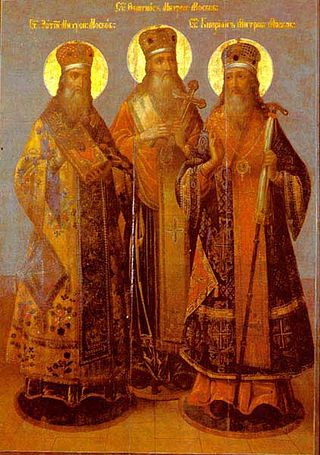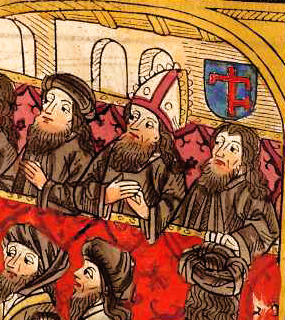
Cyprian was a prelate of Bulgarian origin, who served as the Metropolitan of Kiev, Rus' and Lithuania and the Metropolitan of Kiev and All Rus' in the Ecumenical Patriarchate of Constantinople. During both periods, he was opposed by rival hierarchs and by the Grand Prince of Moscow. He was known as a bright opinion writer, editor, translator, and book copyist. He is commemorated by the Russian Orthodox Church on May 27 and September 16.
The Metropolis of Moscow and all Russia was a metropolis that was unilaterally erected by hierarchs of the Eastern Orthodox Church in the territory of the Grand Duchy of Moscow in 1448. The first metropolitan was Jonah of Moscow; he was appointed without the approval of the Ecumenical Patriarch of Constantinople. The metropolis split from the Metropolis of Kiev and all Rus' because the previous metropolitan — Isidore of Kiev — had accepted the Union of Florence. Seventeen prelates succeeded Jonah until Moscow's canonical status was regularised in 1589 with the recognition of Job by the Ecumenical Patriarch. Job was also raised to the status of patriarch and was the first Patriarch of Moscow. The Moscow Patriarchate was a Caesaropapist entity that was under the control of the Russian state. The episcopal seat was the Dormition Cathedral in Moscow.

Metropolitan Photius of Kiev, was the Metropolitan of Kiev and all Rus' in the Patriachate of Constantinople of the Eastern Orthodox Church. He was of Greek descent.

Jonah of Moscow, was the Metropolitan of Kiev and all Rus'. He reigned from 1448 to his death in 1461. He was appointed at the behest of the secular authorities in Muscovy as his predecessor on the throne — Isidore of Kiev — was adjudged to have apostatized to Catholicism. Like his immediate predecessors, he permanently resided in Moscow, and was the last Moscow-based primate of the metropolis to keep the traditional title with reference to the metropolitan city of Kiev. He was also the first metropolitan in Moscow to be appointed without the approval of the Ecumenical Patriarch of Constantinople as had been the norm. He is recognised as a saint in the Russian Orthodox Church.
The Major Archeparchy of Kyiv–Galicia (Kyiv–Halych) is a Ukrainian Greek Catholic Major Archeparchy of the Catholic Church, that is located in Ukraine. It was erected on 21 August 2005 with the approval of Pope Benedict XVI. There are other territories of the Church that are not located in Ukraine. The cathedral church — the Cathedral of the Resurrection of Christ — is situated in the city of Kyiv. The metropolitan bishop is — ex officio — the Primate of the Ukrainian Greek Catholic Church. The incumbent major archbishop is Sviatoslav Shevchuk.

Gregory Tsamblak or Grigorij Camblak was a Bulgarian writer and cleric. He was the pretended Metropolitan of Lithuania between 1413 and 1420. A Bulgarian noble, Tsamblak lived and worked in Bulgaria, but also in Serbia and then Kiev. His literary works represent a heritage of the national literature of Serbia, particularly the style of Old Serbian Vita made popular in the monasteries of the 12th century.

Michael Rohoza was the Metropolitan of Kiev, Galicia and all Rus' in the Patriarchate of Constantinople of the Eastern Orthodox Church from 1588 to 1596. In 1595, he signed the Union of Brest which moved the metropolis from the ecclesiastical jurisdiction of the Patriarchate of Constantinople to the jurisdiction of the Holy See. By this act, the Ruthenian Uniate Church was formed in the territory of the Polish–Lithuanian Commonwealth. From 1596 until his death in 1599, he held the title of "Metropolitan of Kiev, Galicia and all Ruthenia" in the Ruthenian Uniate Church.
Isaiah Kopinsky was the Metropolitan of Kiev, Galicia and all Rus' in the Ecumenical Patriarchate of Constantinople in the Eastern Orthodox Church from 1631 to 1632.

Sylvester Kossów, Kosiv or Kosov was the Metropolitan of Kiev, Galicia and all Rus' in the Ecumenical Patriarchate of Constantinople in the Eastern Orthodox Church from 1647 to 1657. He reigned during the Khmelnytsky uprising.
Gregory the Bulgarian, or Gregory II was Metropolitan of Kiev, Galicia and all Rus'. His title to the metropolitan see was acknowledged both by the Holy See and by the Ecumenical Patriarchate of Constantinople due to their joint acceptance of the Council of Florence which united the Latin and the Eastern Orthodox Churches for a short period of time.
The Metropolis of Lithuania was a metropolis of the Ecumenical Patriarchate of Constantinople in the Eastern Orthodox Church. It was erected on the territory of the Grand Duchy of Lithuania between 1315 and 1317. It was disestablished in 1371. The seat (cathedra) of the metropolis was initially in Navahrudak. It had only two metropolitan bishops. The establishment took place in the aftermath of the Mongol invasion of Kievan Rus' which was exploited by the rulers of Lithuania to greatly expand their territory. To help legitimize their annexations and to bind their new subjects more closely to the state, the royal powers favoured the erection of a metropolis for the inhabitants of the Grand Principality. To avert the possibility of the state going over to the Holy See, the hierarchs based in Moscow latterly supported the erection of the metropolis as the lesser of two evils. Throughout the existence of the metropolis, the metropolitans struggled for religious control of the Rus' eparchies with the secular and religious powers in the Kingdom of Galicia–Volhynia, the Principality of Tver, and the Grand Duchy of Moscow.

The Patriarch of Moscow and all Rus', also known as the Patriarch of Moscow and all Russia, is the title of the primate of the Russian Orthodox Church. It is often preceded by the honorific "His Holiness". As the ordinary of the Diocese of Moscow, the office holder's direct canonical remit extends only to Moscow; however, as Patriarch, the office holder has a number of church-wide administrative powers as laid down by the charter of the Russian Orthodox Church.
The Metropolis of Halych was a metropolis of the Ecumenical Patriarchate of Constantinople in the Eastern Orthodox Church. It was erected on the territory of the Kingdom of Galicia–Volhynia in 1303 by Patriarch Athanasius I of Constantinople. The episcopal seat of the metropolis was in the city of Halych in the "Cathedral of the Assumption".
The Metropolis of Kiev and all Rus' was a metropolis of the Eastern Orthodox Church that was erected on the territory of Kievan Rus'. It existed between 988 AD and 1596 AD. Canonically, it was under the jurisdiction of the Ecumenical Patriarchate of Constantinople. The episcopal seat (cathedra) was located in the city of Kiev.
The schism between the Ecumenical Patriarchate and part ofitsMetropolis of Kiev and all Rus occurred between approximately 1467 and 1560. This schism de facto ended supposedly around 1560.
Simeon of Kiev was the Metropolitan of Kiev, Galicia and all Rus' in the Ecumenical Patriarchate of Constantinople of the Eastern Orthodox Church.
Jonah Hlezna was the Metropolitan of Kiev, Galicia and all Rus' in the Ecumenical Patriarchate of Constantinople of the Eastern Orthodox Church.
Metropolis of Kiev is an episcopal title that has been created with varying suffixes at multiple times in different Christian churches, though always maintaining the name of the metropolitan city — Kiev (Kyiv) — which today is located in the modern state of Ukraine. Following the Council of Florence and the Union of Brest, there are now parallel apostolic successions: in the Russian Orthodox Church, the Orthodox Church of Ukraine, the Ruthenian Uniate Church and its successors. They include:
The Metropolis of Kiev, Galicia and all Rus' was a metropolis of the Ecumenical Patriarchate of Constantinople in the Eastern Orthodox Church that was erected in 1441. The canonical territory was the western part of the traditional Kievan Rus' lands — the states of the Grand Duchy of Lithuania and the Kingdom of Poland. The episcopal seat was initially in the city of Navahrudak, which is today located in Belarus; later it moved to Vilnius in Lithuania. It was disestablished in 1595/6 with the creation of a new ecclesial body — the Ruthenian Uniate Church.







